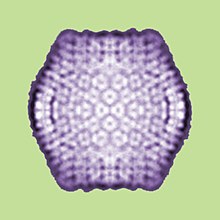Sputnik virophage
| Mimivirus-dependent virus Sputnik | |
|---|---|

| |
| Virus classification | |
| (unranked): | Virus |
| Realm: | Varidnaviria |
| Kingdom: | Bamfordvirae |
| Phylum: | Preplasmiviricota |
| Class: | Maveriviricetes |
| Order: | Priklausovirales |
| Family: | Lavidaviridae |
| Genus: | Sputnikvirus |
| Species: | Mimivirus-dependent virus Sputnik
|
| Member virus | |
| |

Mimivirus-dependent virus Sputnik (from
Viruses like Sputnik that depend on co-infection of the host cell by helper viruses are known as satellite viruses. At its discovery in a Paris water-cooling tower in 2008, Sputnik was the first known satellite virus that inhibited replication of its helper virus and thus acted as a parasite of that virus. In analogy, it was called a virophage.[2]
Sputnik virophages were found infecting giant viruses of Mimiviridae group A. However, they are able to grow in amoebae infected by Mimiviridae of any of the groups A, B, and C.[3]
Virology
Sputnik was first isolated in 2008 from a sample obtained from humans; it was harvested from the contact lens fluid of an individual with keratitis.[4] Naturally however, the Sputnik virophage has been found to multiply inside species of the opportunistically pathogenic protozoan Acanthamoeba, but only if that amoeba is infected with the large mamavirus. Sputnik harnesses the mamavirus proteins to rapidly produce new copies of itself.[2][5]
Mamavirus is formally known as Acanthamoeba polyphaga mimivirus (APMV) and is a close relative of the previously known mimivirus. The mimivirus is a giant in the viral world; it has more genes than many bacteria and performs functions that normally occur only in cellular organisms. The mamavirus is even larger than the mimivirus, but the two are very similar in that they form large viral factories and complex viral particles.[6] There are conditions in which Sputnik cannot produce new virions within these viruses however. It has been observed that when Mimivirus is cultured with germ-free amoeba, bald virions are produced that lack the surface fibers that are characteristic of this virus. For reasons unknown, Sputnik is unable to replicate and produce new virions in these bald viruses.[7] Virophage growth is deleterious to APMV and results in the production of abortive forms and abnormal capsid assembly of APMV. In one of the experiments done by inoculating Acanthamoeba polyphaga with water containing an original strain of APMV, it was discovered that several capsid layers accumulate asymmetrically on one side of the viral particle causing the virus to become ineffective. Sputnik decreased the yield of infective viral particle by 70% and also reduced the amoeba lysis by threefold at 24h.[2]
Sputnik has a circular double stranded
Several other homologues such as those of a
Sputnik was found to contain genes that were shared by APMV. These genes could have been acquired by Sputnik after the association of APMV with the host and then interaction between the virophage and the viral host. Recombination within the viral factory might have resulted in the exchange of genes. Sputnik is one of the most convincing pieces of evidence for gene mixing and matching between viruses.[citation needed]
The presence of these genes homologous to the mimivirus in Sputnik suggests that gene transfer between Sputnik and the mimivirus can occur during the infection of Acanthamoeba. Therefore, it is hypothesized that the virophage could be a source of vehicle mediating
In 2016, for classification of Sputnik-like viruses, including Zamilon, genus
Structure
The Sputnik virophage has a capsid 74 nm in diameter, with
Other viruses of Sputnik genus
Genus Sputnikvirus has two species, which can be divided further into strains:
- Species Mimivirus-dependent virus Sputnik. All three Sputnik virophages share more than 99% of their DNA and can grow with viruses of any Mimiviridae group A, B, and C.[3]
- Sputnik 1 was discovered in 2008. Its host is Mamavirus.[citation needed]
- Sputnik 2 was discovered in 2012. It can infect Acanthamoeba polyphaga Lentille virus (Mimiviridae group A).[3][5]
- Sputnik 3 was discovered in 2013. It was isolated with Mimivirus reporter (which is not its natural viral host).[14][3]
- Species Mimivirus-dependent virus Zamilon. Cannot infect group A due to a MIMIVIRE defense system.[15]
- Zamilon 1 was discovered in 2013 in Tunisia.
- Zamilon 2 was discovered in 2015 in North America.
Other virophages
In March 2011, two additional virophages were described: the
All host viruses of the known virophages belong to the group of
See also
References
- doi:10.1371/journal.ppat.1007592..
 Material was copied from this source, which is available under a Creative Commons Attribution 4.0 International License
Material was copied from this source, which is available under a Creative Commons Attribution 4.0 International License - ^ S2CID 4422249.
- ^ a b c d e f Morgan Gaia et al.: Zamilon, a Novel Virophage with Mimiviridae Host Specificity, in: PLoS One. 2014; 9(4): e94923. Published online 2014 Apr 18. doi: 10.1371/journal.pone.0094923
- PMID 23071316.
- ^ a b c Ed Yong: A Parasite’s Parasites, in: The Scientist, October 15, 2012
- ^ a b Xie, Yun (September 2008). "Sputnik the virophage: a virus gets a virus". ARS technica.
- PMID 21646533.
- PMID 19889775.
- PMID 19653859
- ^ "Biggest Known Virus Yields First-Ever Virophage". Microbe Magazine. November 2008. Archived from the original on 2011-07-22.
- ^ PMID 26446887
- ^ PMID 23091035.
- ^ PMID 19889775.
- ^ Gaia M, Pagnier I, Campocasso A, Fournous G, Raoult D, et al: Broad spectrum of mimiviridae virophage allows its isolation using a mimivirus reporter. PLoS One 8: e61912 (2013) doi: 10.1371/journal.pone.0061912
- S2CID 4382855
- S2CID 206530677.
- ^ Virginia Gewin: 'Virus-eater' discovered in Antarctic lake, in: Nature, 28 March 2011, doi: 10.1038/news.2011.188
- PMID 21444812.
- PMID 23408616.
External links
- Sputnik virophage at ViralZone
- 3D macromolecular structures of the Sputnik virophage at the EM Data Bank
- "Sputnik virophage". NCBI Taxonomy Browser. 543939.
